Chemical attack is a destructive force in any high-tech manufacturing process. For TIMET’s Las Vegas, Nev., plant, the force was presenting itself during the high temperature mixing of titanium tetrachloride (TiCl4), known in the industry as TiCL.
TIMET is a supplier of high-quality titanium metal products. With its unique combination of strength, light weight, corrosion resistance and other metallurgical properties, the company’s titanium is used in hundreds of diverse aerospace, industrial and emerging applications.
TIMET searched for a consulting company to determine the best way to seal the shaft entry point in its high-temperature mixing tanks where the TiCL was batched. The aggressive chemical has a tendency to flash off and form a potentially noxious vapor and toxic white cloud, making worker safety an issue. In addition, when the chemical contacts water, it can become hazardous.
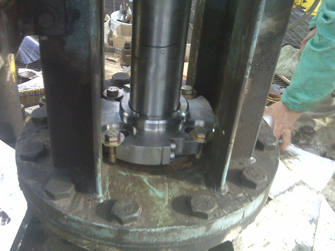 |
The TIMET mixer |
The Challenge
How could TIMET develop a more effective way to seal each tank? Two major challenges loomed. The first was to determine how to maintain a strong, positive seal. The seal design was of paramount importance, and critical metallurgy issues existed as well.
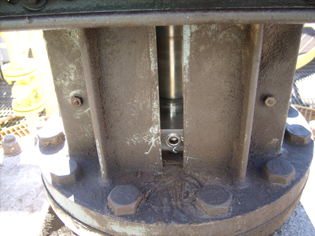 |
| A mechanical seal installed on one of the Philly mixers |
Previously, the system employed a double mechanical seal with a mineral oil barrier fluid that provided lubrication between the inboard and outboard faces. The customer had planned to use a split mechanical seal because it offered a quick replacement time.
However to enhance the operation, a dry seal was needed. The problem? No one made a dry running seal.
The second obstacle was the length of the shaft. The mixing operation used a long, unsupported shaft, which created excessive run out at the mechanical seal.
The Solution
The company recommended that DuPont Vespel CR6100 be installed as the bearing sleeve material. The additional sleeve would help the long shaft run true and minimize shaft run out at the mechanical seal.
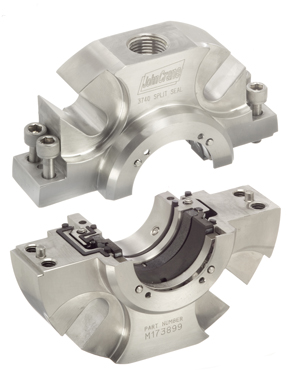 |
| Dry running split seal |
The typical clearance for a steady bearing for a shaft of this diameter is 0.0020 side to side for a total of 0.040-inch clearance. The Vespel sleeve bearing that was used had been machined for a total clearance of 0.007 inch to 0.010 inch. This reduction in clearance between the bearing and shaft was so dramatic, the Vespel sleeve bearing acted as a primary seal and minimized shaft run out well below acceptable levels.
The reason that the clearances could be reduced to this level had to do with the coefficient of thermal expansion (CTE). Dupont Vespel 6100’s thermal growth is confined to the Z direction (along the shaft) while keeping the growth in the X and the Y directions extremely low. In addition to the unique CTE properties of the material, Vespel is chemically inert to the TiCL and can operate without lubrication because of the very low coefficient of friction of this material.
The consulting company redesigned the mixer stuffing box to accommodate a John Crane Type 3740D using the Vespel sleeve bearing, one of the first dry running beta split seals installed by John Crane.
Final Analysis
During the final assembly of the bearing and split seal system, the engineering team experienced a slight dimensional issue that initially prevented them from installing the seal. As a result, time was short and the mixer had to be placed back into service. Both TIMET and the engineering team were pleased to see that the Vespel sleeve bearing alone was sealing nearly 100 percent of the vapor.
The engineering team and plant officials decided to leave the unit in operation without the split seal while the minor dimensional issue was addressed. At the first opportunity, the dry running split seals were installed on the mixers to ensure that the vapor leakage would be completely contained.
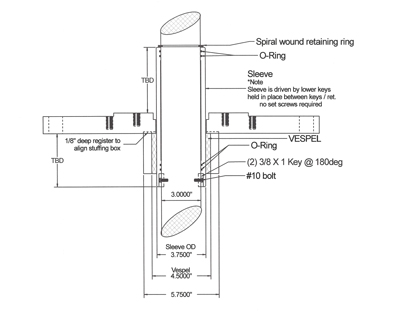 |
| The adjustments made to themixer stuffing box |
The Vespel sleeve bearing demonstrated reduced run out as a temporary seal. The team made the dimensional modifications to the system and standardized all the components.
Conclusion
Several vessels within the plant that were experiencing problems similar to the first vessel were fitted with a dry running split seal in their mixers as well as Dupont Vespel 6100 sleeve bearings, resulting in the containment of all TiCl vapor. The split seal, which was installed during a very brief outage, operated without a hitch (a double seal would have required days versus hours to install).
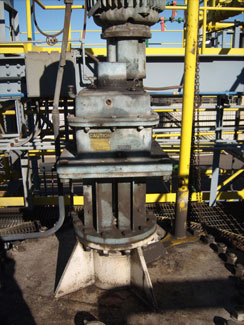 |
| A new John Crane mechanical seal (hidden from view) provides a complete tank seal for the modified mixer system. |
The cost of running the enhancements to the TIMET system reduced downtime and the requirements for complex seal support systems. The fact that mineral oil barrier fluid was not required with the split seal, as it is with a double mechanical seal, was a major enhancement.
This saved money, specialized seal support equipment to regulate flow and pressure to the seal and reduced the amount of time required to replace mechanical seals in the future.
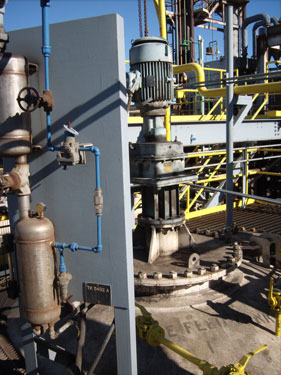 |
| The seal support system that was eliminated after the modification |
For all the tanks, the combination of the dry running split seal and the Dupont Vespel sleeve, along with other modifications, resulted in total success. As a result of the work completed to date, the engineering team members are incorporating all the new modifications as standard offerings for new mixers that the company purchases for its plant. The assessment of the mixers’ needs began in late 2010, and final installation on both tanks will be completed by the end of 2011.

